Can You Deadlift on a Smith Machine? Yes, Here's How
Sometimes, every barbell in the gym is taken, and you haven’t got the time to wait for one to become available.
In training programs where the deadlift is a central fixture, this can absolutely be an issue. But rather than throwing in the towel and coming back another time, a better approach might be to try performing the deadlift with the use of a smith machine.
While the answer is somewhat more complicated than a simple yes - it is entirely possible to perform a deadlift (or a variation of it) with the smith machine. A few adjustments in technique will be needed, but the benefits and results will remain much the same.
What is a Smith Machine, And How Do You Deadlift With it?
Before we examine the minute details of the smith machine deadlift, we should first identify what a smith machine even is.
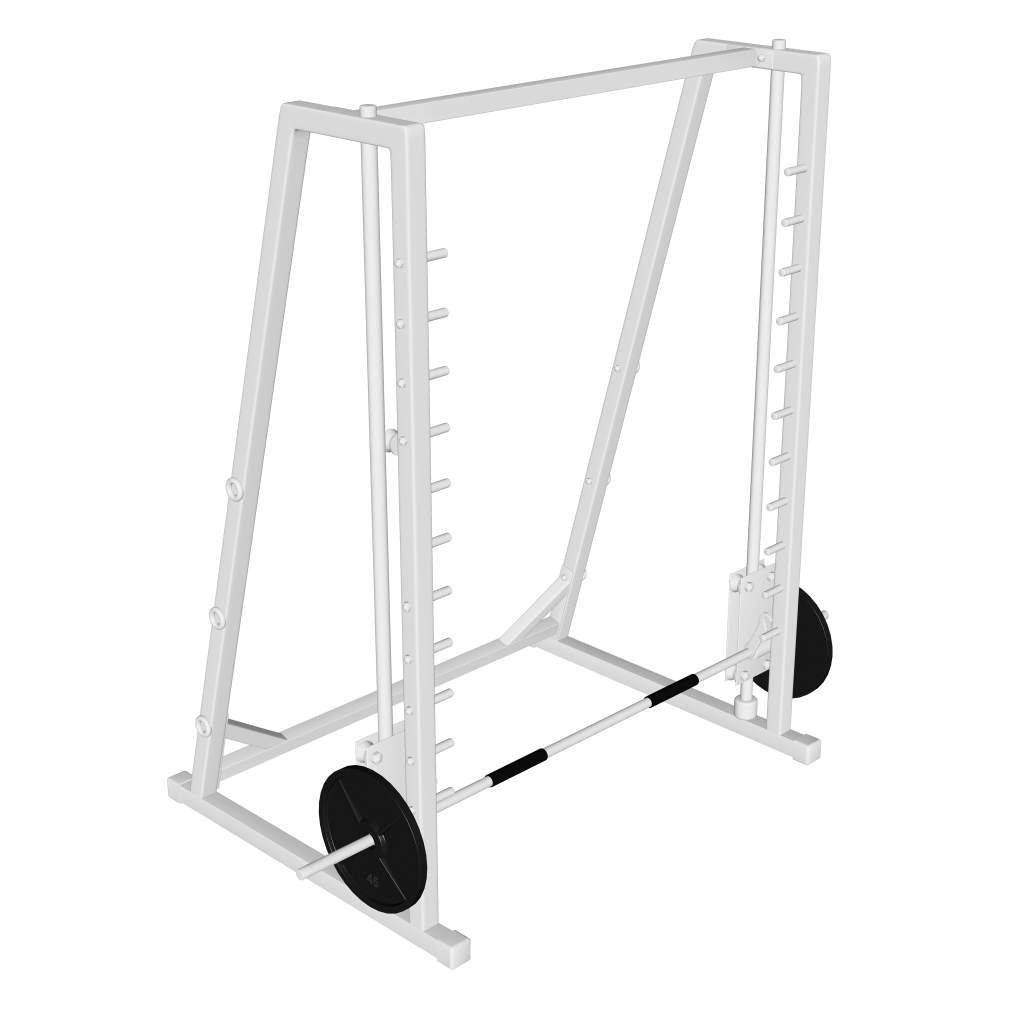
The smith machine is a type of resistance training equipment visually similar to a barbell rack, but with a barbell held in place along a linear vertical path so as to improve the safety of the lifter and allow any weight added to be self-stabilizing.
Smith machines will often require the usage of weight plates attached to both ends of the bar, and allow for said bar to be “racked” or “unracked” by rotating it forwards and backwards so as to engage safety hooks located along the sides of the bar.
Deadlift Variations That are Possible With a Smith Machine
While there are quite a number of different free weight deadlift variations, not all can be performed with the smith machine due to the limitations of its design.
Barring a few highly obscure deadlift variations, it is primarily the conventional, sumo, Romanian and stiff-legged deadlifts that are done with the use of a smith machine.
Are Smith Machine Deadlifts Different From Regular Deadlifts?
For the most part, any deadlift performed with the smith machine will recruit much the same primary muscles as one performed with free weight equipment.
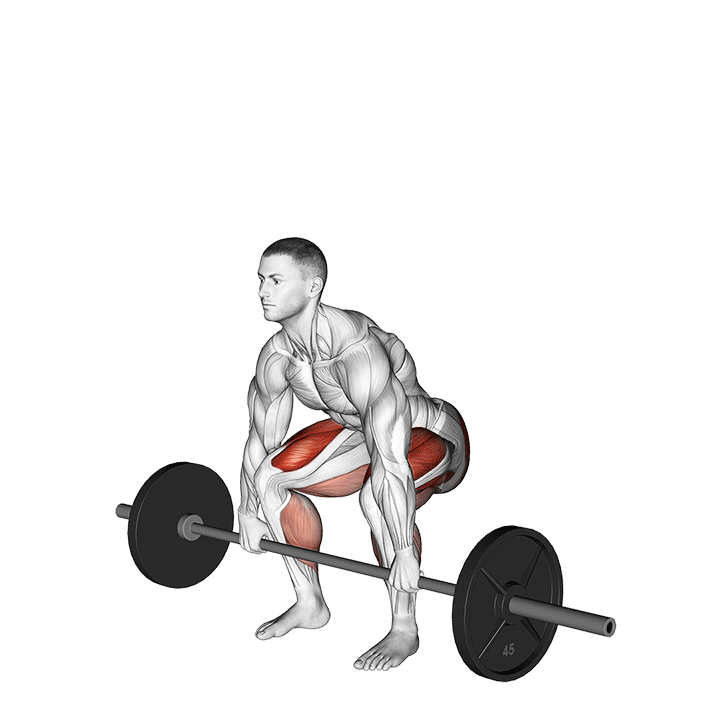
The general mechanics involved (such as hip hinging and knee extension) remain identical between the two types of deadlifts, and lifters switching from free weight deadlifts may find the smith machine variation to in fact be easier to perform.
However, that isn’t to say that doing deadlifts with a smith machine isn’t without its own disadvantages - especially for powerlifters or individuals who wish to perform free weight deadlifts later in their career.
The Disadvantages of Smith Machine Deadlifts
Because the bar of a smith machine is limited in how low it can be placed, the range of motion of any smith machine deadlift will be shorter than if it were performed with free weights. This can lead to issues like sticking points, instability in the posterior chain and poor initial pulling strength in free weight deadlift variations.
In addition to a shorter range of motion, the self-stabilizing nature of the smith machine means that stabilizer muscle recruitment is greatly diminished as well.
This can lead to muscular imbalances and general instability elsewhere in the lifter’s life, as well as reduce the rate at which their musculature will develop.
The Conventional Smith Machine Deadlift
The conventional deadlift is much the same exercise one thinks of when the term “deadlift” is used, although some changes in stance may be needed if you are switching from free weight deadlifts to a smith machine one.
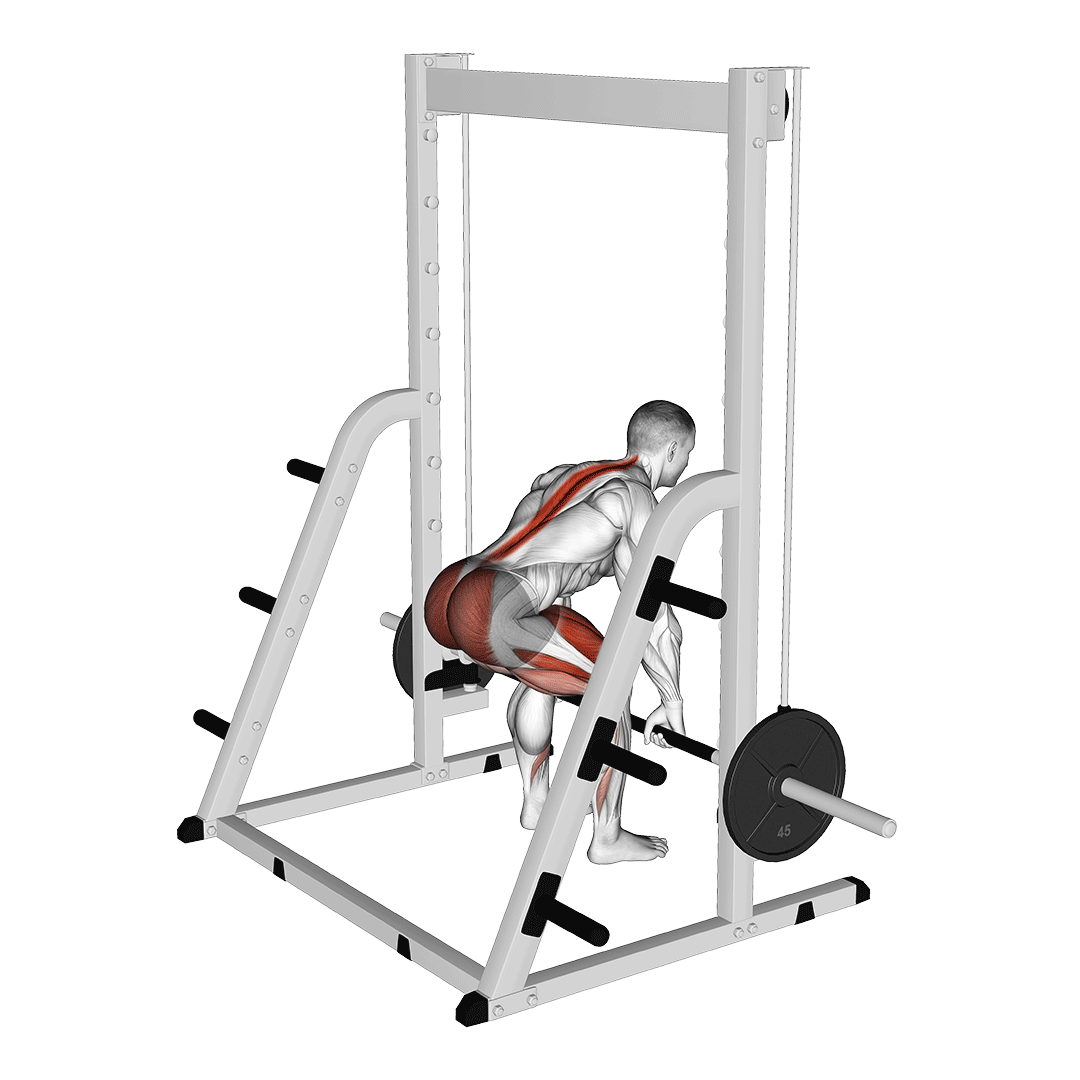
Like all other deadlift variations, the conventional smith machine deadlift is a multi-joint compound exercise performed with a significant amount of resistance for low-volume sets. It is considered to be somewhat technical in execution, and may not be suitable for novice lifters or those with a history of injury.
Muscles Worked
The conventional smith machine deadlift works the quadriceps, hamstrings, glutes and erector spinae to a highly intense and dynamic capacity - while simultaneously using muscles like the forearms, trapezius, calves and core as stabilizers, albeit to a lesser extent than with free weights.
Benefits as a Smith Machine Deadlift Variant
The conventional deadlift is considered to be one of the most effective exercises for building lower body muscle size and strength - a fact made even more accessible due to the inherently lower risk of injury, shorter range of motion and lower stabilization demands of the smith machine.
Furthermore, the smith machine deadlift in particular can allow for greater comparative loading and volume to be achieved, so long as it is also aligned with the lifter’s training goals.
How-to:
To perform a conventional smith machine deadlift, the lifter will rack the bar at its lowest depth, safety hooks engaged. A moderate to heavy load may be added to the bar as well.
Standing upright with the feet set shoulder-width apart and the shins making contact with the bar, the lifter will bend at the hips and knees as they grip the barbell in a double-overhand grip. The core must remain contracted, the chest pushed out and the spine in a neutral position throughout the set.
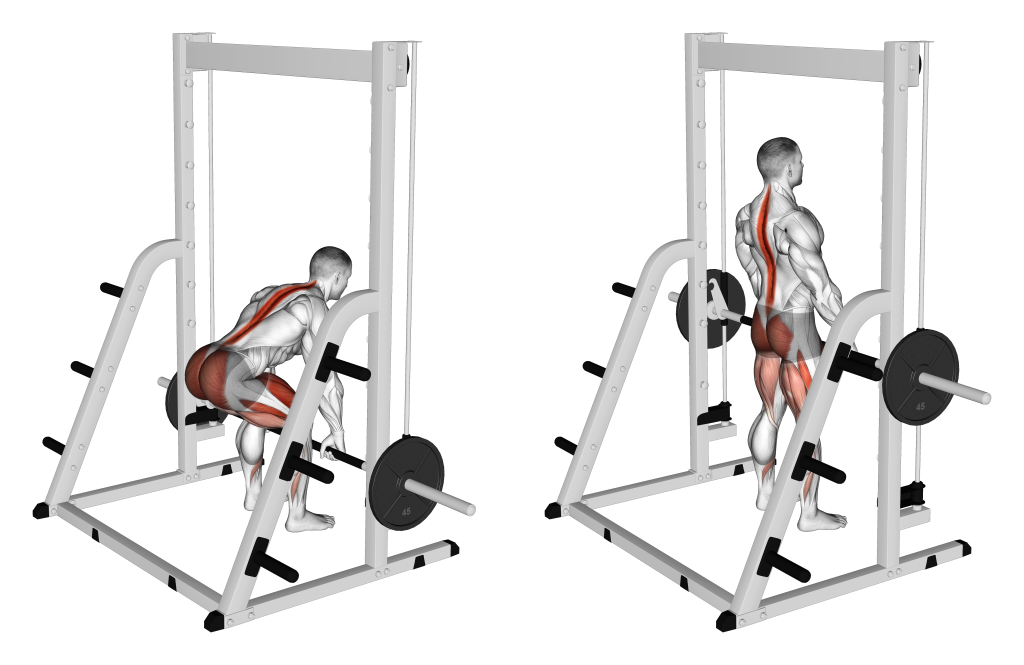
Pushing the hips forward and driving through the heels, the lifter will extend their knees and draw the smith machine’s bar upwards, stopping once the knees and hips are fully extended.
Once the lifter’s hips and knees are fully extended, the repetition is considered to be complete.
Due to the limited bar path of the smith machine, the lifter may not be able to reach full extension or have the capacity to draw fully backwards as they push the hips forwards. This must be accounted for with subsequent flexing of the core and additional attention paid to form cues.
The Smith Machine Sumo Deadlift
For lifters who prefer a wider stance or wish to emphasize the muscles of the glutes and quadriceps, performing a sumo deadlift with the use of a smith machine is also entirely possible.
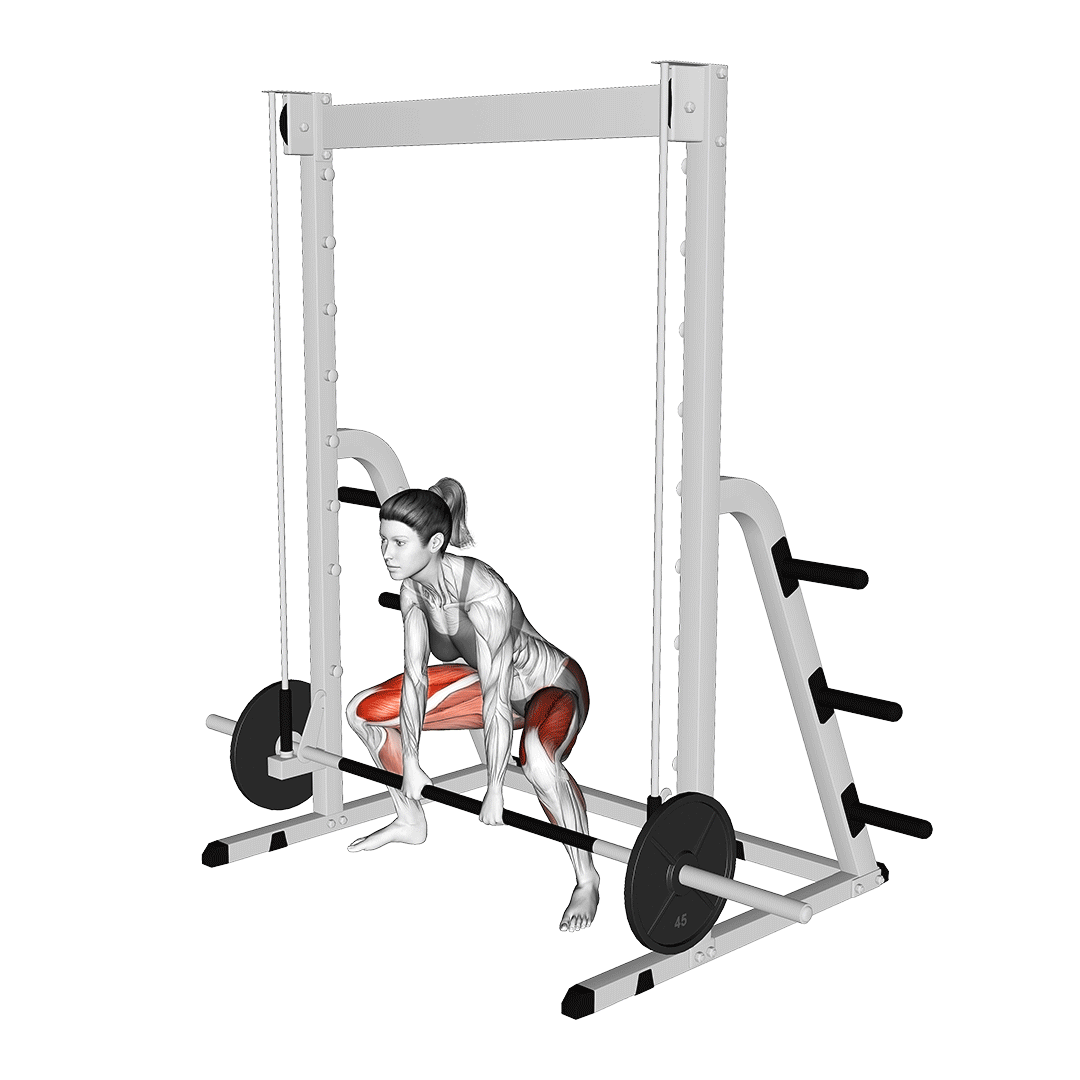
Much like the conventional variation of the smith machine deadlift, the smith machine sumo deadlift is a multi-joint compound exercise of similarly high resistance and generally low volume.
It is often used as a substitute to the conventional variation for individuals that find the wider stance to be more comfortable - although the inherent limitations of the smith machine may make performing this deadlift variation somewhat more difficult.
Muscles Worked
The smith machine sumo deadlift recruits the glutes and quadriceps to the greatest extent - but also works the hamstrings and erector spinae alongside them. Muscles like the forearms, core, calves and trapezius are also used in an isometric capacity.
Benefits as a Smith Machine Deadlift Variant
The sumo deadlift variation of the smith machine deadlift features an even wider stance and a greater emphasis on the glutes and quadriceps - but also an even shorter range of motion.
Depending on the lifter’s training goals, this can be quite useful for correcting a sticking point or practicing a specific portion of the sumo deadlift.
Furthermore, the wider stance involved can help mitigate some of the shortcomings of the smith machine’s fixed bar path, allowing the lifter to pull more readily and in alignment with the slightly angled tilt of the bar.
How-to:
To perform a smith machine sumo deadlift, the lifter will set the bar at its lowest depth and assume the conventional sumo stance by planting the heels wider than shoulder-width apart, the core contracted and the spine neutral as their hands grip the bar between their legs.
The legs and knees are bent at the start of the repetition, and the bar touches the shins.
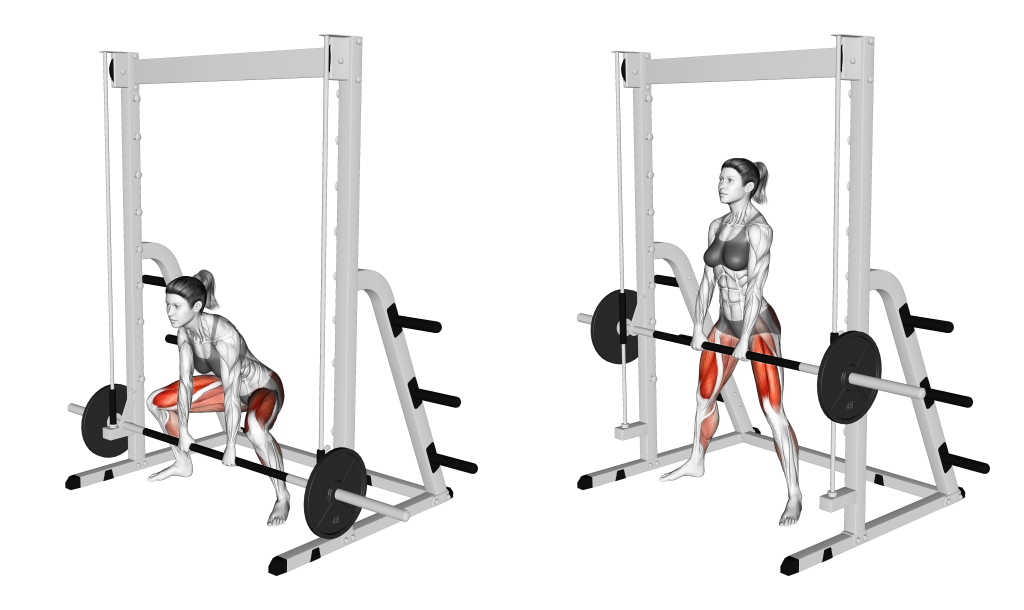
To begin the repetition, the lifter will push through their heels and extend their knees as they push their hips forwards, making sure to track the knees at an outward-facing angle, rather than allowing them to cave inwards.
Once the knees and hips are fully extended, the repetition is considered to be complete.
The Smith Machine Romanian Deadlift
Occasionally abbreviated to just “RDL”, the Romanian deadlift is a classic deadlift variation meant to further target the muscles of the posterior chain - in particular, the hamstrings.
The exercise is made even more effective when performed with the use of a smith machine, as doing so can allow for greater isolation of the hamstring muscles and less involvement of the quadriceps muscles due to the inherently higher starting depth of the smith machine’s bar.
Unlike the aforementioned sumo or conventional smith machine deadlifts, the smith machine Romanian deadlift is considered to be an isolation exercise that targets more than a single muscle.
Muscles Worked
The smith machine Romanian deadlift primarily works the hamstrings and glutes, while simultaneously recruiting the erector spinae, core and forearms as stabilizer muscles.
Benefits as a Smith Machine Deadlift Variant
Much like the free weight Romanian deadlift, the smith machine Romanian deadlift is excellent for building up muscle mass in the posterior chain while simultaneously reinforcing hip-related biomechanics.
In particular, the smith machine Romanian deadlift allows for more energy to be diverted towards recruiting the posterior chain musculature - and greater volume, as limiting factors like fatigue of stabilizer muscles is less of a factor.
How-to:
To perform a repetition of the smith machine Romanian deadlift, the lifter will set their feet hip-width apart with the knees slightly bent, the core firmly contracted and the spine kept in a neutral position throughout the set.
The bar should be racked at approximately mid-thigh prior to beginning the repetition.
Standing upright and facing the smith machine bar, the lifter will keep their knees bent as they push their pelvis back and hinge the torso forwards, the bar held in a double overhand grip.
Continuing the movement of their hip hinge, they will lower the bar to just below the knees before pushing the pelvis forward and drawing it upwards once more, extending the hips and straightening the torso. From this point, the repetition is considered to be complete.
The Stiff-Legged Smith Machine Deadlift
The stiff legged deadlift is similar to the Romanian deadlift in its capacity for targeting the posterior chain in isolation - something made all the more effective with the use of the smith machine.
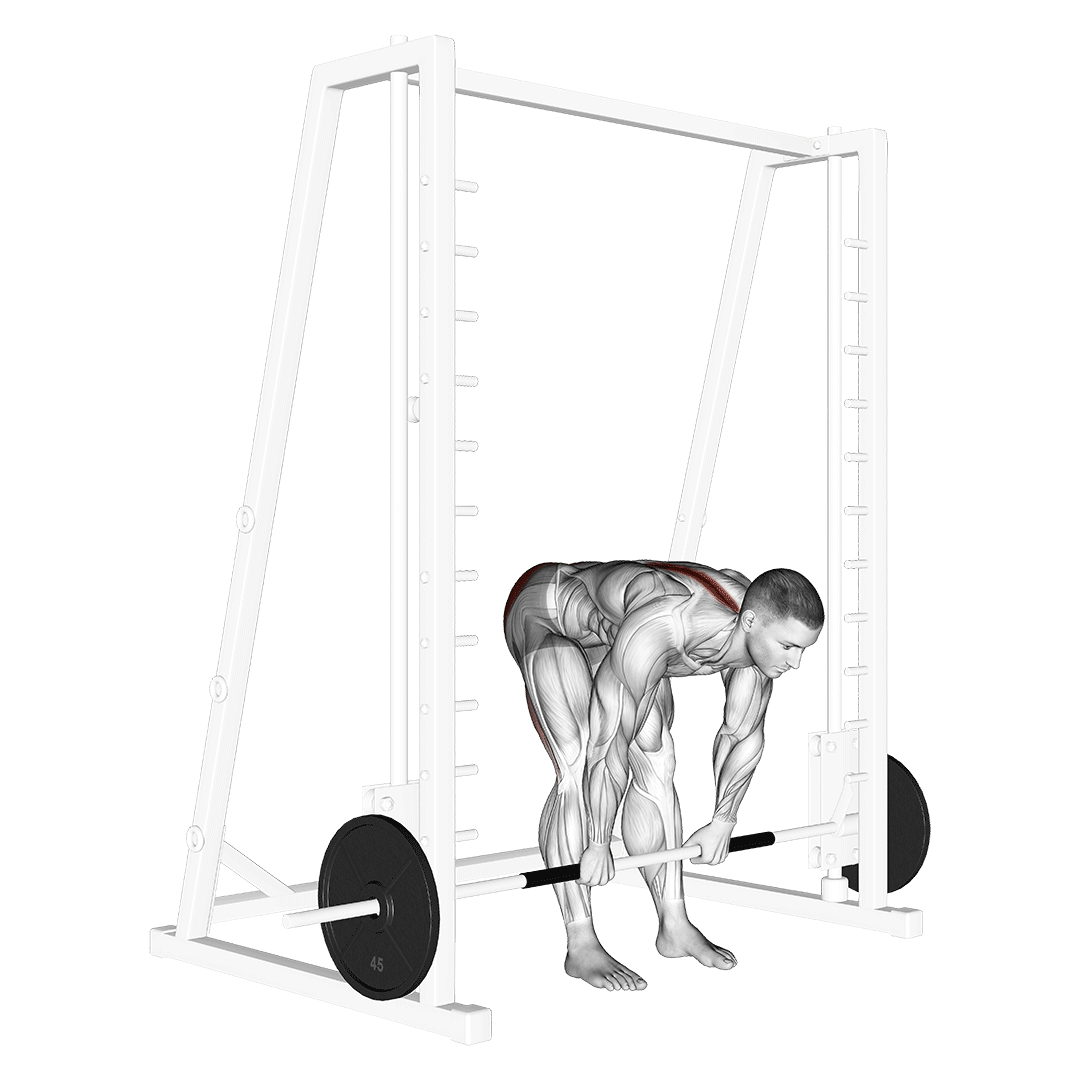
Like the smith machine Romanian deadlift, the stiff-legged smith machine deadlift is primarily an isolation exercise that benefits from the intrinsic self-stabilizing nature of the smith machine, as well as its more fixed bar path and capacity to rack the bar at certain points.
Muscles Worked
The smith machine stiff-legged deadlift works the hamstrings, glutes and erector spinae - while also using the forearms and core as stabilizing muscles.
Benefits as a Smith Machine Deadlift Variant
The smith machine variation of the stiff-legged deadlift is particularly useful as it provides nearly no difference in mechanics or range of motion, yet features self-stabilizing resistance and a lower risk of injury.
Not only does this make the smith machine stiff-legged deadlift safer, but it also means that more volume can be performed without problems like muscular fatigue acting as a limiting factor.
How-to:
To perform a repetition of the smith machine stiff-legged deadlift, the lifter will stand with their feet set hip-width apart and the smith machine’s bar racked at approximately mid-thigh.
The hands should grip the bar in a double overhand grip with the feet facing forwards and the core firmly contracted so as to protect the lower back.
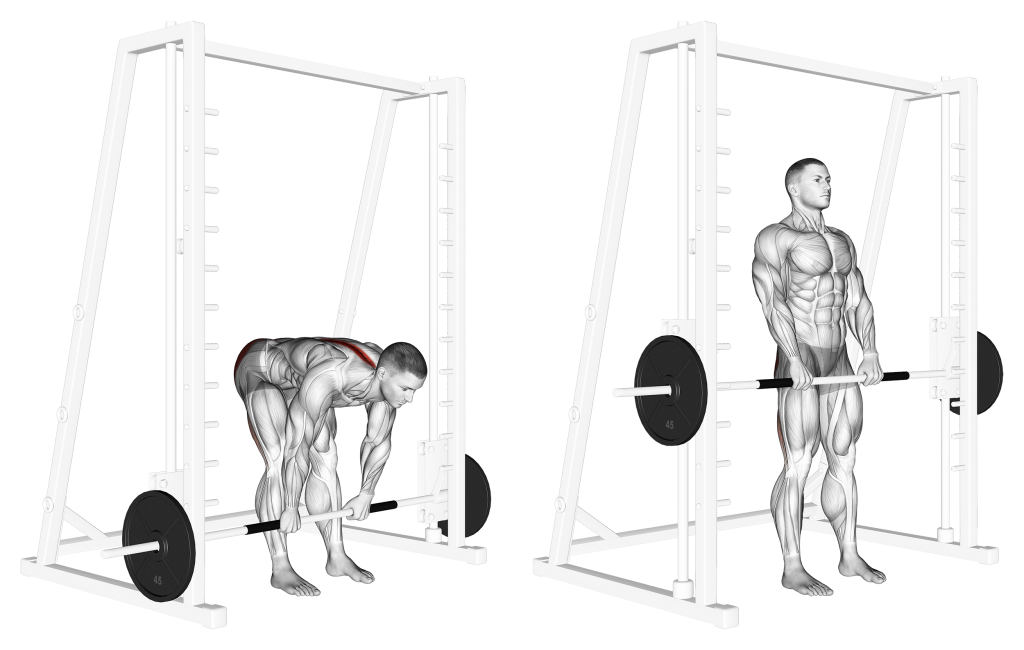
Then, unracking the bar, the lifter will hinge at the hips by pushing their pelvis back and lowering the bar as the torso swings downwards, keeping the knees bent as little as possible throughout the motion.
Once the torso is parallel to the floor or the hamstrings are at the limit of their mobility, the lifter will squeeze their gluteal muscles and push their pelvis forwards, drawing themselves back into a standing position and thereby completing the repetition.
Which Smith Machine Deadlift is the Best?
In truth, there is no “best” smith machine deadlift, as each of the aforementioned smith machine deadlift variations are tools meant for different purposes.
While the conventional or sumo deadlifts are the most likely to be used as primary compound movements, the Romanian deadlift and stiff-legged deadlift are meant more as accessory exercises to further the workout’s training stimulus.
If we are going entirely by which deadlift is most compatible with the smith machine, then the Romanian or stiff-legged deadlift are arguably the best, as they benefit the most from the characteristics of the smith machine.
Keep in mind that these exercises will feature little to no carryover to their free weight counterparts due to poor stabilizer muscle recruitment and generally different movement patterns, of which may lead to poor execution and sticking points.
Tips for Performing Smith Machine Deadlifts Safely
Keep the Bar Touching the Body
Just as is the case with free weight deadlifts, it is important for the smith machine’s bar to remain touching the body throughout each repetition.
This is applicable regardless of what specific deadlift variation is being performed, as doing so will stop the weight from improperly leveraging the body and straining the lower back.
Stand on the Right Side of the Bar
Smith machines are built with the bar angled several degrees towards one side, often in the same direction as the rest of the machine’s frame.
For the safest and easiest smith machine deadlift, the lifter should strive to stand on the side that aligns the bar path towards their body, rather than away from it. This ensures that the bar remains touching the body throughout the repetition, and that it does not force the lifter to extend their lower back or break proper form adherence.
Beginning the Repetition too High (or Low)
The smith machine’s bar will often hook into specific points along its vertical path, meaning that the lifter will not be able to engage the safety hooks if it is between two points. This can make beginning a repetition somewhat complicated if the lifter’s ideal starting point is also in such an area.
Lifters should ensure that the bar is racked at the appropriate elevation for their exercise prior to beginning, as starting it too low (such as with the stiff-legged or Romanian deadlifts) can expend more energy than is needed, whereas too high can effectively reduce the range of motion of the first repetition.
Final Thoughts
When performing deadlifts with the smith machine, the question is less of whether it is possible and more of whether it is a good idea.
In actual practice, the free weight deadlift is arguably superior to its smith machine counterpart in nearly every way - but this doesn’t mean that the smith machine deadlift is entirely without purpose.
If you are a novice, a lifter just returning to resistance training or have been prescribed the smith machine deadlift by your coach so as to rehabilitate your mobility/injuries - then yes, the smith machine deadlift is doubtless the right exercise for you.
References
1. Saeterbakken AH, Olsen A, Behm DG, Bardstu HB, Andersen V. The short- and long-term effects of resistance training with different stability requirements. PLoS One. 2019 Apr 1;14(4):e0214302. doi: 10.1371/journal.pone.0214302. PMID: 30934001; PMCID: PMC6443166.
